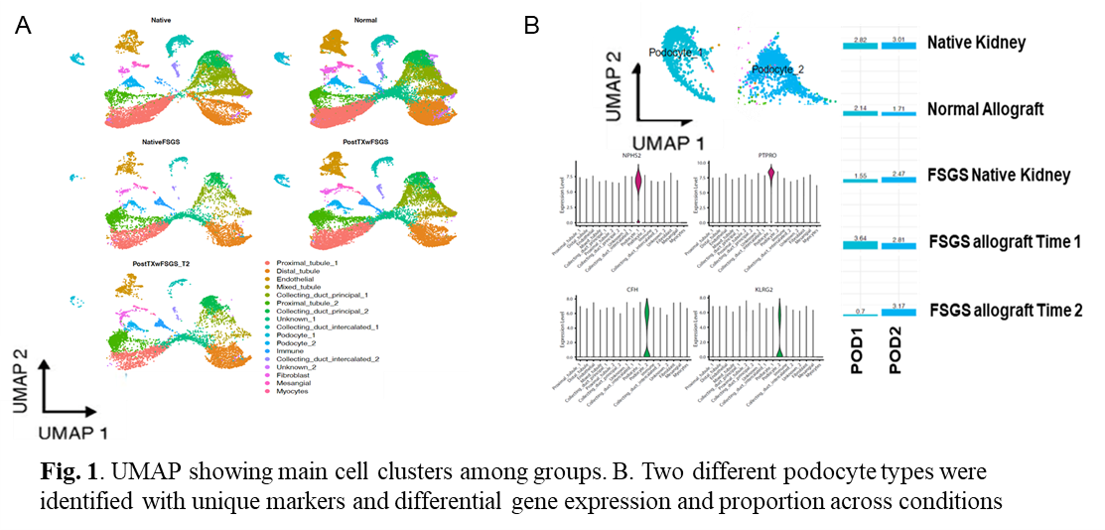Single Nuclei RNA-Sequencing Identifies Distinct Cell Profile in Kidney Allografts with Recurrent Focal Segmental Glomerular Sclerosis (FSGS)
1NWU, Chicago, IL, 2University of Maryland, Baltimore, MD, 3UTHSC, Memphis, TN
Meeting: 2022 American Transplant Congress
Abstract number: 500
Keywords: Gene expression, Genomics, Graft function, Kidney transplantation
Topic: Clinical Science » Kidney » 49 - Recurrent Kidney Disease & Genetics
Session Information
Session Name: Recurrent Kidney Disease & Genetics
Session Type: Rapid Fire Oral Abstract
Date: Tuesday, June 7, 2022
Session Time: 5:30pm-7:00pm
 Presentation Time: 5:40pm-5:50pm
Presentation Time: 5:40pm-5:50pm
Location: Hynes Room 310
*Purpose: Strong evidence suggests that primary FSGS is due to a plasma factor that results in general podocyte dysfunction and risk of recurrence after kidney transplantation (KT). Despite several candidates for the plasma circulating factor(s) have been proposed the pathogenesis of FSGS remains unknown. Here we aimed to identify origin, functional heterogeneity, and cell-to-cell interactions to discern the effectors and targets of injury in both native and transplant kidneys affected by primary FSGS.
*Methods: Single nuclei were isolated from healthy native kidney (NK, n=3), native kidney with FSGS (NK-FSGS), n=1), normal kidney allografts (NA, n=4) and kidney allografts with FSGS recurrence (FSGS-KT, n=6). 64,494 nuclei in Gel-Bead V3 were captured by using the droplet-based 10X Genomic Chromium Platform. Data was analyzed in CellRanger 3.1.0. Cell clustering using PCA followed by uniform manifold approximation and projection (UMAP) was done. Distinct clusters of cells based on GE of highly variable genes were identified. GE patterns between clusters were evaluated to find cluster-specific marker genes.
*Results: 17 cell clusters were identified from total samples representing main components of the kidney (Fig. 1A) with the identification of two types of podocytes (POD1 and POD2) (Fig. 1B). Subcluster analyses showed 10 immune cell populations and high heterogeneity in endothelial cells (10 sub-clusters). POD2 were predominant in both NK-FSGS and KT-FSGS samples. Analyses of differentially expressed genes (DEGs) showed that these cells were characterized by decreased focal adhesions and upregulated ECM-interaction, N-glycan biosynthesis, and mTOR signaling pathways. Immune cells were increased in NK-FSGS compared to NK but significantly more increased in KT-FSGS recurrence. Critically, memory T cells were increased in all FSGS samples while B cell subsets were only increased in KT-FSGS recurrence. NK-FSGS were characterized by activated fibroblasts and proximal tubule cells with a fibroblast-like phenotype.
*Conclusions: This is the first study showing the single nucleus transcriptome landscape of native and transplanted kidneys with FSGS. FSGS is characterized by unique kidney and immune cell subtypes with characteristic transcriptional profiles leading and expanding the kidney injury.
To cite this abstract in AMA style:
Gallon L, Bardhi E, McDaniels J, Shetty A, Hallack P, Kuscu C, Kuscu C, Rousselle T, Eason J, Maluf D, Mas V. Single Nuclei RNA-Sequencing Identifies Distinct Cell Profile in Kidney Allografts with Recurrent Focal Segmental Glomerular Sclerosis (FSGS) [abstract]. Am J Transplant. 2022; 22 (suppl 3). https://atcmeetingabstracts.com/abstract/single-nuclei-rna-sequencing-identifies-distinct-cell-profile-in-kidney-allografts-with-recurrent-focal-segmental-glomerular-sclerosis-fsgs/. Accessed November 15, 2025.« Back to 2022 American Transplant Congress

